|
Report
Effect of DREAMMO Scalp Lotion on Hair Growth Promotion in Alopecia Model of C57BL/6 Mice
Research Institute for The Development of Pharmaceutical Resource, College of Pharmacy, Chungbuk National University
Abstract
I. Title : Effect of DREAMMO Scalp Lotion on Hair Growth Promotion in Alopecia Model of C57BL/6 Mice
II. Introduction
Hair loss, regardless of its type, is a common and distressing phenomenon. Recently, hair loss or thinning have increased markedly in young age as well as middle age. Although hair loss can be associated with the several different conditions, heredity, stress, medications, diet, hormonal problems, infections and autoimmune disorders can all cause hair loss. Thus, it is very important to develop new therapeutic materials to prevent hair loss and to enhance hair growth. DREAMMO Scalp Lotion is composed of several plant extracts which are known to be used in oriental medicine and is developed as an agent which prevented hair loss or promoted hair growth. This study was carried out to investigate the effect of DREAMMO Scalp Lotion on hair growth in an alopecia model of C57BL/6 mice.
III. Methods
Hair of six-week old mice were shaved by an electric clipper. Mice were separated into the three experimental groups including negative control, DREAMMO Scalp Lotion and 3% minoxidil(MXD). The test compounds were topically treated with 0.2 ml per mouse per day for 4 weeks. The hair growth was determined photographically in alopecia model of C57BL/6 mice after topical application of test compounds for 4 weeks. Histological observation of hair growth was performed as compared with controls.
IV. Results
The topical treatment of DREAMMO Scalp Lotion for 4 weeks to dosal skin accelerated hair growth faster than negative control treatment after 15 days. After 3-4 weeks, DREAMMO Scalp Lotion significantly increased hair growth in the skin of C57BL/6 mice as compared with the negative control. In histological observation, DREAMMO Scalp Lotion promotes hair follicle elongation compared with the negative control. These results suggest that DREAMMO Scalp Lotion has a potential hair growth activity and is useful for the treatment of hair loss.
I. Introduction
Hair in human is not only the protection of cranial bone, but also the function of beauty. Therefore, the improvement and activation of hair growth, the prevention of the hair loss would be focused with the increase of interests. Recently, there has been an increasing number of people suffering from hair loss or thinning. This results from the cultural change such as the increases of stress and female work, unbalance of nutrients beyond the genetic factors.
Although it has been studying for the improvement of hair growth and the hair loss, it has not been clearly reported yet why these phenomena appeared. Many researches lately have been studying for these areas in the universities and industrial laboratories. Thus, it is very important to develop new therapeutic materials to prevent hair loss and to enhance hair growth. Since ancient times, many chemicals have been tried to cure baldness, however, only two drugs so far have been approved for hair loss treatment by the Food and Drug Administration(FDA, USA) ; i.e., minoxidil and finasteride. Minoxidil in Pharmacia & UpJohn Corp. was originally developed for a vasodilator but it was also found to stimulate the hair growth. It was not clearly elucidated why it happened but the increase of nutrient supply and potassium channel opening effect might result in the improvement of hair growth. Finasteride in Merck Corp. is a type II 5¥á-reductase inhibitor as the enzyme related with the metabolism for the male hormone.
For the study of the improvement and activation of hair growth and the prevention of alopecia, there are two types of experiments such as in vivo for the animal test and in vitro for the hair follicle cell cultivation. As the cultivation methodologies of dermal papilla cell and outer root sheath cell as a major cell of hair follicle were developed, the differentiation of hair follicle have been actively studied. Later, as the cultivation method for the organization of hair follicle was developed, it obviously showed the possibility to use the evaluation model for the tests for the prevention of alopecia and the improvement and activation of hair growth. According to the development of molecular biology and biochemistry, the research for drug treatment and functional group, the factors for the hair growth and genetical mechanism would be actively studying thesedays. However, cultivation method in vitro has the limits such as the exclusion of circulation of blood and each cell function within the hair follicle. Thus, most reagents would be commonly evaluated for the effectiveness by the animal test and/or clinical trial. Animals used for the tests of the hair growth and prevention of alopecia are stump tailed macaque, rabbit, hamster, mouse, and etc.
In this study, liquid formulation (DREAMMO Scalp Lotion) would be evaluated for the enhancement of hair growth. The evaluated method was well known as the effectiveness test with use of C57BL/6 mice. The hair color in C57BL/6 mice is black and the characteristic is that it has spontaneous alopecia. Since melanocyte limitedly existed in the hair follicle and synthesis of melanin is well matched along with the hair growth cycle, it takes the advantage for the test because it can be easily recognized by skin color to determine its hair growth cycle.
Each hair from male and female 6-week old C57BL/6 mice back was removed by an electric clipper. DREAMMO Scalp Lotion and control agents were applied into the hair shaved area in the mice 6 times a week, everyday. The improvement of hair growth were examined and photographed by every 7 days during 4 weeks. Histological observation were performed with the area of hair growth in the mice.
II. Methods
II-1. Preparation of DREAMMO Scalp Lotion
DREAMMO Scalp Lotion (granted from JAYEON-e-NARA) contains L-Mentol, salicylic acid, D-panthenol and several herbal extracts from the chinese medicines.
II-2. Test Animal
Using 6-week old C57BL/6 mice(Deahan Biolink Corp.), the hair-growing activity to induce the anagen phase was performed. 5-week old mice were in the laboratory for a week to be accustomed to the circumstance. The temperature in the mouse breeding laboratory was 23 _ 3¡É and relative humidity was 50 _ 10%. The light was started from 7 a.m. to 7 p.m. for 12 hours and light intensity is 150 - 200Lux. Experimental groups consist of each 3 different group of male and female. Total groups are 6 and 1 group has 10 different mice (5 males, 5 females). Ultimately 60 mice were tested for this experiment.
Test animals were breed in the separate mouse cages which was made by Samkwang Corp. Feed were provided freely by Samyang Feed Corp.
II-3. Treatment
The hair on the back of each mouse(6-week-old) was shaved with an electric clipper so as not to injure or stimulate the skin. Mice without visible scratches were randomly selected and separated into 3 groups(n=10) as described above.
The application of the testing agents have been started everyday for 30 days in the beginning of the day after hair-shaving. The one dosage is 0.2 milliliter(§¢) per ten square centimeter(§²) of hair shaved area. All test were performed with the equity classification for average weight through the pooling the different embryo mouse.
The testing compounds are as follows.
Distilled water (hereinafter, DW) as a negative control
DREAMMO Scalp Lotion (hereinafter, DREAMMO or DreamÙ¾)
Minoxidil (hereinafter, 3% MXD) as a positive control
II-4. Weight Measurement
The weight of mice was measured at a fixed time as once a week from the application of the agents to the end of the test.
II-5. ASSESSMENT
The photographs in the anesthetized conditions were taken from 7 days past after the starting date of the test for 4 weeks.
The different effectiveness between DREAMMO and the control were shown in the treated area of the mice as the level of hair growth. (the ratio of the area of hair growth in the shaved area) The level of hair growth is scored after observation(see Table 1). Score of each group was compared with Student t-test of statistical method.
II-6. Histological Observation
Dorsal skin from both DREAMMO and control groups were extracted by dissecting tool and fixed by formalin at 30 days. Dewatering by alcohol and xylene stepwisely and after enbedding paraffin, 5§(five micrometer) material was prepared using a microtome. And then paraffin was removed by alcohol and xylene. After dyeing with hematoxylin and eosin, the shape of hair follicle was observed by the optical microscope.
Table 1. Scoring for Hair growth effectiveness
|
?Level of Hair growth |
?Scoring |
|
No growth |
0 |
|
less than 30% |
1 |
|
30% - 70% |
2 |
|
more than 70% |
3 |
III. Results
To investigate whether anagen phase induction was stimulated by DREAMMO, we evaluated hair-growing activity in C57BL/6 mice. C57BL/6 mouse dorsal hair is known to have a time-synchronized hair growth cycle. All hair follicle in C57BL/6 mouse after the birth were grown into hair growth at the beginning of anagen. Telogen would be started from around 3 weeks after the birth and then 2nd anagen would begin again. All hair follicle would be starting for the telogen phase at 6 - 8 weeks. Since the telogen phase lasts more than 4 weeks, the mouse gives the sufficient time to assess the enhancement of the hair growth. Additionally, melanocyte limitedly exist in hair follicle and synthesis of melanin is well matched along with hair growth cycle. The telogen phase can easily be recognized by the presence of pink skin, and the anagen phase by dark gray. Namely, as the initial anagen phase in C57BL/6 mouse was synchronized and the telogen phase at about 7-week old mouse was long enough, the effectiveness of the hair growth would be well assessed by this method. In this study, 6-week old mouse was tested for the effectiveness of hair growth improvement.
The mice treated with DREAMMO did not show any visible side effects compared with the control group. The weight of the treated female would decrease a little but the one of the applied male would not be changed(Fig 1 and 2). The rate of skin color change for the transition into the anagen phase in female would be much faster than in male mouse. The result showed that the female dorsal color change would be more clearly observed than one of male.
DREAMMO group(male, female) showed rapid dorsal color change to gray in 10-15 days. The dorsal color was changed into blue in the partial or full shaved area in a few days. The improvement of hair growth in testing group could be observed in the short time period. The hair growth rate in female mouse is much faster than the one in male mouse. After 20 days past for this experiment, it demonstrated that more than 1/2(one-half) of DREAMMO group had the evidence of the black hair growth. Contrastively, the rate of hair growth in the control group was much slower than the one in DREAMMO(Fig 3 and 4).
By the comparison with the scoring(by table 1), the rate of hair growth and change of dorsal color in DREAMMO Scalp Lotion is a little bit slower than those treated with Minoxidil. However, the rate of hair growth and change of dorsal color in DREAMMO Scalp Lotion were prominently faster than those in the control group. DREAMMO group presents the excellent hair growth promotion based on the statistical aspects (p£¼0.001) compared with the control.
The extracted dorsal tissues at 30 days dyed with hematoxylin and eosin to study the change of hair follicle shape in each group. The shape of hair follicle would be observed by the optical microscope. Both DREAMMO group and Minoxidil group have the thicker skin, deeper depth and longer shape of hair follicle than the control. The length and position of hair follicle are important factors as the determination parameters of hair growth cycle. As the results of this study, DREAMMO group showed the faster transition to the anagen phase compared with the control (Fig 5 and 6).
Recently, there has been an increasing number of people suffering from hair loss or thinning. This results from the cultural change such as the increases of stress and female work, unbalance of nutrients beyond the genetic factors. Since ancient times, many chemicals have been tried to cure baldness, however, only two drugs so far have been approved for hair loss treatment by the Food and Drug Administration(FDA, USA) ; i.e., minoxidil and finasteride. Minoxidil in Pharmacia & UpJohn Corp. was originally developed for a vasodilator but the improvement of hair growth was also reported. It was not clearly elucidated why it happened but the increase of nutrient supply and potassium channel opening effect might result in the improvement of hair growth. Finasteride in Merck Corp. is a type II 5¥á-reductase inhibitor as the enzyme related with the metabolism for the male hormone.
The some components of DREAMMO Scalp Lotion are extracted from the chinese medicines such as Glycyrrhizae Radix, Angelicae Acutiloba Root, Acori Gramineri Rhizoma, Cnidii Rhizoma, Polygoni Multiflori Radix, Coix Seed. These medicines are well known as folk remedies for the protection of sclerosis of the arteries, the decrease of blood pressure and the expansion of the peripheral blood vessel based on the traditional and scientific basis. Because of their pharmacological actions, we speculated that these herbs might promote hair growth, and we now demonstrated that DREAMMO possesses hair-cycle converting activity in C57BL/6 mice in vivo, which was similar to the effect of minoxidil. Since the plant extracts of DREAMMO Scalp Lotion contain these types of effectiveness, it would be expected to provide the nutrients and oxygen to hair root. These effectiveness is very important for the growth of hair root cell.
Among them, Job's tears also plays the role of a conditioning agent in DREAMMO Scalp Lotion. The components of Job's tears are myristiric acid, ¥â-sitosterol, campesterol, stigmasterol and so on. Myristiric acid and ¥â-sitosterol are reported as the inhibitors of 5¥á-reductase. The major components of Glycyrrhizae Radix are glycyrrhetinic acid as terpenoid, glycyrrhetizin and flavonoid. Additionally, glycyrrhetinic acid and glycyrrhetizin are also known as the inhibitor of 5¥á-reductase. These reports support the possibility of the effectiveness of hair growth improvement through the secretion control of male hormone.
Based on these experiments and the references, DREAMMO Scalp Lotion has a potent hair growth promoting effect.
IV. Discussion
To assess the effectiveness of the improvement of hair growth, after each hair from male and female C57BL/6 mice back was shaved by an electric clipper, 0.2 milliliter of distilled water as control, DREAMMO Scalp Lotion and 3% minoxidil have been treated to the hair shaved area in mouse back for 4 weeks. DREAMMO group showed the fast hair growth rate at around 15 days of the treatment compared with control. Big differences of the hair growth effectiveness between DREAMMO and control could be observed at 3 - 4 weeks.
Although the rate of hair growth in DREAMMO Scalp Lotion is a little bit slower than the one in Minoxidil, the rate of hair growth and change of dorsal color in DREAMMO Scalp Lotion were prominently faster than those in the control. DREAMMO presents the excellent hair growth rates based on the statistical aspects (p£¼0.001) compared with the control. Mice treated with DREAMMO Scalp Lotion showed the thick skin, the deep depth and long shape of hair follicle in the hair-shaved area and the result of histological observation demonstrated that the shape of hair follicle existed in the deep dorsal skin.
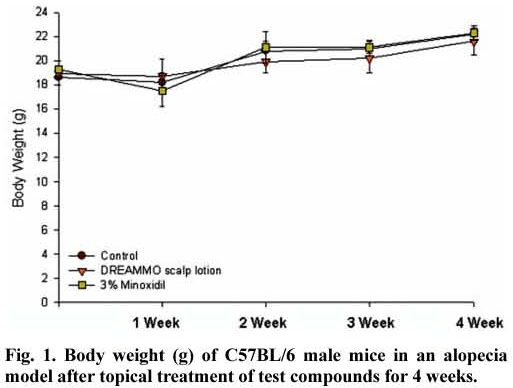
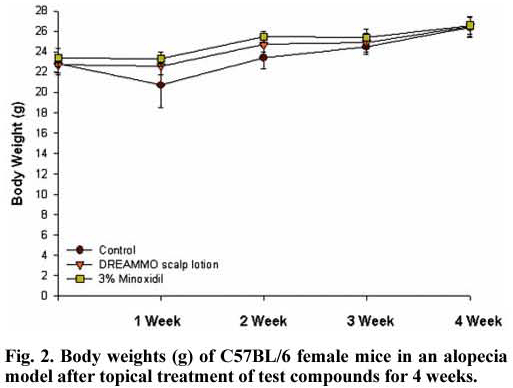
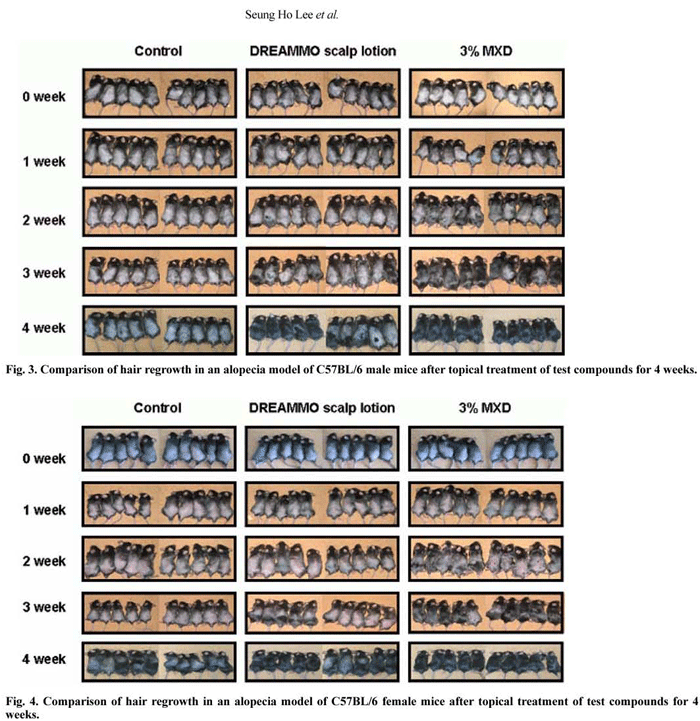
Table 1. Scoring of hair regrowth in alopecia models of C57BL/6 male mice(n=10)
|
|
Control |
DREAMMO |
Minoxidil |
|
0 Week |
0 |
0 |
0 |
|
1 Week |
0 |
0 |
0.8 |
|
2 Week |
0 |
0.7 |
2.5 |
|
3 Week |
0 |
1.4 |
2.8 |
|
4 Week |
0 |
2.5 |
3.0 |
- Score = Total score / n
Table 2.? Scoring of hair regrowth in alopecia models of C57BL/6 FEMALE mice(n=10)
|
|
Control |
DREAMMO |
Minoxidil |
|
0 Week |
0 |
0 |
0 |
|
1 Week |
0 |
0.1 |
0.6 |
|
2 Week |
0 |
0.4 |
1.9 |
|
3 Week |
0.1 |
1.6 |
2.9 |
|
4 Week |
1.5 |
2.6 |
3.0 |
- Score = Total score / n
* Table 1. Scoring for Hair Growth Effectiveness
Level of Hair growth |
?Scoring |
|
No growth |
0 |
|
less than 30% |
1 |
|
30% - 70% |
2 |
|
more than 70% |
3 |
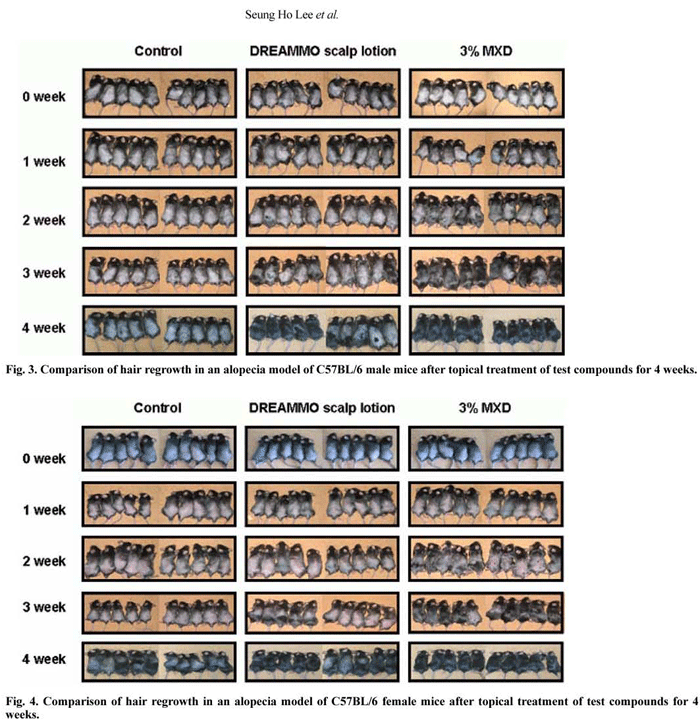
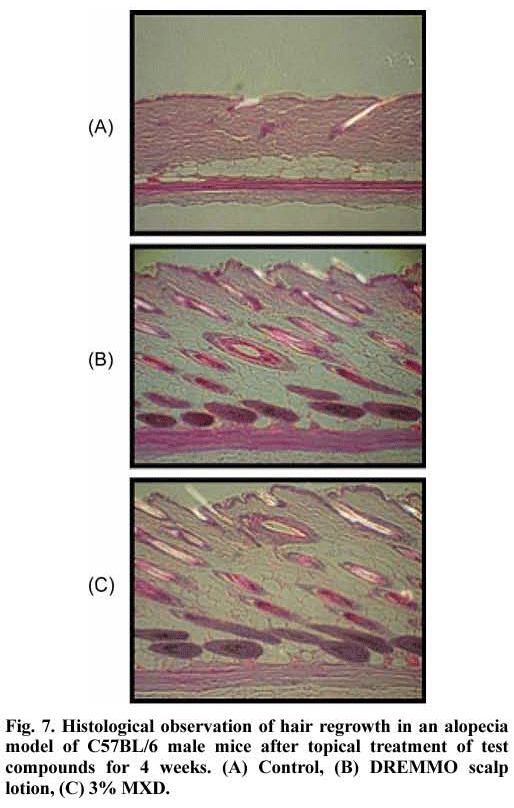
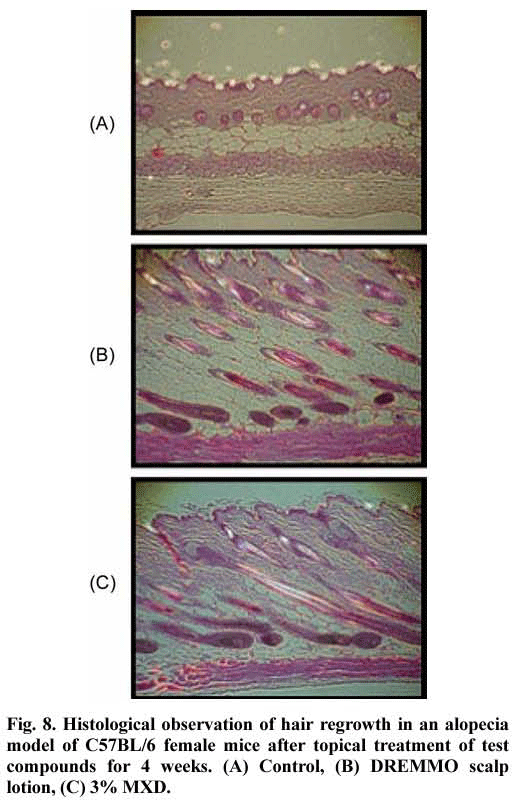
Reference
Stenn, K.S. : The molecular and structura1 biology of hair : introduction. Ann N. Acnd. Sci 642, xi-xiii (1991)
Buhl, A. E., D. J. Waldon B. F. Miller and M. N. Brumen : Differences in activity of minoxidil and cyclosporin A on hair growth in nude and normal mice Lab. Invest. 62, 104-107 (1990)
Jiang H., S. Yamamoto and R. Kato : Induction of anagen in telogen mouse skin by topical application of FK506, a potent immunosuppressant. J Invest. Dermatol 104, 523-525 (1995)
Burton J. L. and A. Marshall : HyPerthchoasis due to minoxidil. Br. J. Dermatol.101, 593-595 (1979)
Meisheri K. D., L. A. Cipkus and C. J. Tayor : Mechanism of action of minoxidil suIfate-induced vasodilation : a role for increased K+ permeability. J. Pharmacol.Exp. Ther. 245, 751-760 (1988) .
Buhl, A. E., D. J. Waldoln, C. A. Baker and G. A. Johnson : Minoxidil sulfate is the active metabolite that stimulates ha1r follicles. J. Invest. J. Dermatol. 95, 553-557 (1990) .
Messenger A.G. : The control of hair growth and pigmentation. In Disorders of Hair Growth (eds Elise A Olsen), McGraw-Hill, New York p.39-58 (1994) l
Kaufrnan, K. D.: Clinical studies on the effects of oral finasteride, a type 5-reductase inhibitor, on scalp hair in men with male pattern baldness. In Hair Research for the Next Millenium (eds D. Neste and V. A. Randall), Elsevier, Amsterdam, p.363-365 (1996)
Uno, H.: Quantitative models for the study of hair growth in vivo. Ann N. Y. Acad Sci 642 107-124 (1991)
Limat, A., D. Breitkreutz, H-J. Stark, T. Hunziker, G. Thikoetter, F. Noser and N. Fusenig : Experimental modulation of the differentiated phenotype of keratinocytes from epidermis and hair foIlicles outer root sheath and matrix ceIls. Ann, N. Y; Acad. Sci.642, 125-147 (1991)
Buhl, A. E., D. J. Waldon, T. T. Kawabe and J. M. Holland : Minoxidil stimulates mouse vibrissae follicles in organ culture.J. Invest. Dermatol. 92. 315-320 (1989).
Jahoda C. and R. F. Oliver : The growth of vibrissae dermal papilla cells in vitro. Br J. Dermatol. 105, 623-627 (1981) _.
Messenger A. G., H. Jennifer and S. S. Bleehen : The in vitro properies of dermal papilla cell lines established from human hair follicles. Br. J. Dermatol 114, 425-430 (1986)
Yang J. S., R M. Lavker and T. T. Sun : Upper hair follicle contains a subpopulation of keratinocytes with superior in vitro proliferative potential. J. Invest; Dermatol. 101 652-659 (1993)
Philpott M. P., M. R. Green and T. IKaley : Human hair growth in vitro. J. Cell Sci97. 463-471 (1991)
Yamamoto, S., H. Jiang and R. Kato : Stimulation of hair growth by topica1 l application of FK506, a potent immuosuppressive agent. J Invest. Dermatol. 102. 160-164 (1994)
Pals, R., K. S. Stenn and R. E. Link : The induction of anagen hair growth in telogen mousa skin by cyclosporin A administration. Lab. Invest. 60, 365-369 (1989) .
Kawabe T. K., M. F. Kubicek, G. A. Johnson and A. E. Buhl : Use of -glutamyltransferase activity as a marker of hair cycle and androgen induction in mouse hair follicles. J. Invest. Dermatol.103, 122-126 (1994)
PallS, R., K. S . Stenn and R. E. Link : Telogen skin contains an inhibitor of hair .growth. Br. J. Dermatol. 122, 777-784 (1990)
J.P. Raynaud , H. Cousse , P.M. Martin . (2002) Inhibition of type 1 and type 2 5alpha-reductase activity by free fatty acids, active ingredients of
Permixon. J. Steroid. Biochem. Mol. Biol. 82(2-3):233-9.
M. Yoshida , Y. Kuroki , E. Kobayashi, B. Tamaoki . (1992) Kinetic mechanism of reduction of testosterone by hepatic 5 beta-reductase of chicken and inhibition of the reductase activity by a secosteroid, an azasteroid and glycyrrhetinic acid. J. Steroid. Biochem. Mol. Biol. 41(1):29-36.
Table 1. Scoring of hair regrowth in alopecia models of C57BL/6 male mice(n=10)
|
|
Control |
DREAMMO |
Minoxidil |
|
0 Week |
0 |
0 |
0 |
|
1 Week |
0 |
0 |
0.8 |
|
2 Week |
0 |
0.7 |
2.5 |
|
3 Week |
0 |
1.4 |
2.8 |
|
4 Week |
0 |
2.5 |
3.0 |
- Score = Total score / n
Table 2. Scoring of hair regrowth in alopecia models of C57BL/6 FEMALE mice(n=10)
|
|
Control |
DREAMMO |
Minoxidil |
|
0 Week |
0 |
0 |
0 |
|
1 Week |
0 |
0.1 |
0.6 |
|
2 Week |
0 |
0.4 |
1.9 |
|
3 Week |
0.1 |
1.6 |
2.9 |
|
4 Week |
1.5 |
2.6 |
3.0 |
- Score = Total score / n
* Table 1. Scoring for Hair Growth Effectiveness
Level of Hair growth |
?Scoring |
|
No growth |
0 |
|
less than 30% |
1 |
|
30% - 70% |
2 |
|
more than 70% |
3 |
|